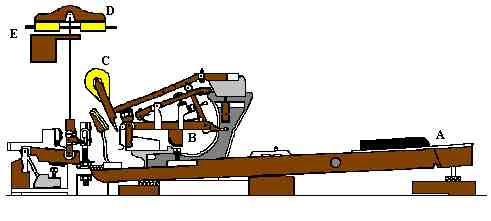|

(801)
255-TUNE Click to Schedule Appointment
|
Interesting
Facts about the
Piano:
- The
Piano
was invented in 1698
by an Italian, Bartolomeo Cristofori.
- There
are
over 12,000 parts in a piano, 10,000 which are moving.
- There
is
approximately 18
tons of pressure being exerted by the stretched steel piano
strings.
In a concert grand, it is close to 30 tons of pressure.
The
average
string having about 160 pounds of tension. There are 230 strings inside
a typical piano.
- The
action of a grand is superior
in many ways to a vertical piano, one being that any key can be
repeated
(reset) faster than any vertical upright (regardless of the name given
by manufacturers i.e.: upright grand, studio grand, inverted grand,
etc.).
- If
all of
the strings were
of the same thickness and under the same tension, with high C
being
the usual two inches, low C would have to be about thirty
feet
long.
For this reason, lower strings are weighted by wrapping copper or iron
wire around the core wire. The lowest octave having two wrappings.
- If a
piano hammer were attached
directly to the back end of a key, when the key was depressed, the
hammer
would hit the string and stay there, damping out all vibration and
sound.
For this reason, all piano actions have some kind of escapement
mechanism
for each key, allowing the hammer to be released from the key
just
before
hitting the string. When the key is released, the action
returns to
its original position and resets itself for another cycle.

Basic
parts of a piano action,
include:
A - Key
; B - Escapement (sticker
& whippen);
C - Hammer; D - Damper; E - String
Most pianos
have two to three
pedals.
- The
right
pedal is always
the sustaining pedal (damper pedal), it raises all
of the
dampers
at once, allowing all notes which are played to continue sounding after
the keys are released.
- The left
pedal is always
some type of soft pedal. In vertical pianos, and
some grand's,
it
moves the hammers at rest closer to the strings, decreasing their
travel,
and thus striking force. In most grand's, the soft pedal shifts the
entire
action sideways, causing the treble hammers to hit only two of their
three
strings. The lower strings are shifted to another part of the hammer
felt. The
shifting
type of soft pedal is called the una corda pedal.
- The third
or
middle
pedal
is usually called the sostenuto pedal. It sustains
only those
notes
which are depressed prior to and while holding the pedal down, and does
not sustain any notes depressed after holding it down. This is like
having
a third hand to sustain certain notes, while playing others.
- In
some
instances, the middle
pedal is the bass sustaining pedal, which lifts
only the bass
dampers.
Some uprights use the middle pedal as a practice pedal,
which
lowers
a thick piece of felt between the hammers and strings, muffling the
tone.
Once in awhile, you will see the middle pedal being used to lower metal
studded tab strips between the hammer and the string, creating a tinny
honky-tonk type sound. This is often called a Zither,
Harp
or Mandolin.
 |

Piano Tuning | Regulation
| Repair
Servicing
Communities
along the Wasatch Front
|